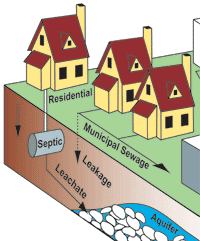
Photo from wikipedia
This paper reports an experimental degradation study of nineteen multi-class pharmaceutical products present in the influent wastewater arriving at the Daugavgriva wastewater treatment plant. Collected wastewater samples were filtered and… Click to show full abstract
This paper reports an experimental degradation study of nineteen multi-class pharmaceutical products present in the influent wastewater arriving at the Daugavgriva wastewater treatment plant. Collected wastewater samples were filtered and irradiated by electron beam and gamma radiation both generated from a 5 MeV linear particle accelerator. The samples were exposed to ten absorbed doses (0.5–25 kGy) produced at high dose rates (600 and 1200 kGy h−1 for accelerated electrons, as well as 22.5 and 37.5 kGy h−1 for gamma radiation). The analysis by a sensitive liquid chromatography–mass spectrometry method indicated that the initial concentrations of pharmaceutical residues were effectively reduced by up to 90–100% in eighty per cent of the cases when samples were exposed to 0.5–5 kGy of electron beam or gamma radiation treatment. Higher doses (>5 kGy) were needed to decompose macrolide antibiotics. The use of electron beam radiation showed some advantages due to the reduced exposure time, thus enabling a more energy efficient treatment resulting in the degradation of pharmaceutical residues comparable to that achieved by gamma irradiation. Microbiological studies indicated the pronounced degradation effect on bacterial contamination of wastewater, which was successfully eliminated upon increasing the radiation, dose up to 7–12 kGy.
Journal Title: International Journal of Environmental Science and Technology
Year Published: 2017
Link to full text (if available)
Share on Social Media: Sign Up to like & get
recommendations!